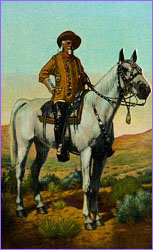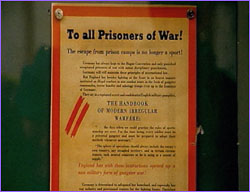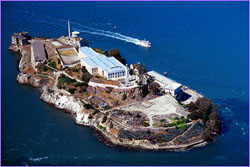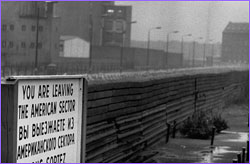 |
 |
| 
Buffalo Bill Cody
|
Great Escapes
Part 2 | Back to part 1
William F. Cody (Colorado)
Popularly
known as Buffalo Bill, William F. Cody was a buffalo hunter, U.S. Army Scout,
and Indian fighter who helped create the myth of the Wild West with his
traveling variety show, the melodramatic "Wild West Congress of Rough Riders of
the World." Known for his accurate marksmanship, courage, endurance, and brutal
fights with Indians, Cody made one of the most fearless escapes in American
history.
In the early 1860s, Indians captured Cody near Fort Larned, Colorado. Knowing
that his captors' supply of meat was low, Cody convinced them to let him lead
them to a nearby herd of cattle he knew of. Though a large group surrounded him
as they traveled, Cody, who was allowed to ride in front, eventually broke free
and urged his mule into a brisk canter. For six miles, the Indians pursued
Cody, who never had more than a half-mile lead. Though the Indians shot arrows
at him and tried to knock him off his mule, Cody prevailed, eventually slipping
unnoticed into a Fort Larned bar and escaping.
The Great Escape (Germany)
Nazi authorities took great pains to guard against the escape of their
prisoners during World War II at both their horrifying civilian concentration
camps and at prisons for captured members of the Allied forces. At one of the
largest prisons for Allied airmen, Stalag Luft III, the Germans planted
seismographs in the ground every 33 feet so that they could detect the sounds
of tunneling. They also raised the prison huts off the ground on stilts so that
they could observe suspicious digging activity and built a huge trench around
the entire prison to form yet another barrier between the prisoners and
freedom. Despite all these measures, Stalag Luft III saw one of the biggest
mass escapes of all time.

After Hitler ordered the deaths of 50 would-be escapees at Stalag Luft III prison, Allied forces posted notices warning POWs at other prisons not to attempt escape.
|
|
The Germans set the stage for a massive escape when they chose to put nearly
10,000 strong, militarily trained men in Stalag Luft III together. Free to
move about the prison, these men had nothing better to do than put their
collective brainpower and might towards an escape plan. Among the inmates in
1944 were scores of talented miners, carpenters, engineers, even physicists and
geologists, all of whom were willing to help execute an escape.
The escape committee was run by a South African airman named Robert Bushell,
who devised a plan in 1943 to dig three tunnels, "Tom," "Dick," and "Harry."
Fully 30 feet deep, each tunnel would lie beyond the reach of the listening
devices. As they dug, the prisoners removed tunnel dirt by trolley, concealed
it in the legs of their pants, and later dumped it inconspicuously around the
prison grounds. Groups of prisoners took turns guarding the tunnels from the
watchful eyes of the Germans and covering for "missing" prisoners when they
were underground.
On the 24th of March, 1944, 76 men were able to escape through the
tunnels. Unfortunately, only three of them reached safety. Fifteen were
captured and returned to the prison. Eight were sent to a concentration camp
(though they ultimately survived the war). The remaining 50, Bushell among
them, were rounded up and shot on orders from Hitler himself, who was
embarrassed and infuriated by the mass escape. Hoping to deter any further
prison breaks, Hitler ordered the ashes of the 50 murdered men scattered at
Stalag Luft III by other prisoners.
Dalai Lama XIV (Tibet)
When they gained control of China in 1949, the Communists under Mao Tse Tung
vowed to erase religion in China and regain economic and political power of the
country's so-called "autonomous regions." Tibet, with its rich natural
resources and friendly, pious inhabitants, became an immediate target. In 1959,
as Communist armies stormed the Tibetan capital of Lhasa, the Dalai Lama,
Tibet's spiritual and political leader, decided he had to try to escape from
his homeland in hopes that he could lead his people from a safer perch in
exile.
| 
The Dalai Lama at his home in exile,
Dharamsala, India.
|
While huge crowds of Tibetans swarmed around the Dalai Lama's summer palace in
an attempt to protect him from advancing troops, the Dalai Lama disguised
himself in work clothes and crept unnoticed through the crowds and out of the
city. "For the first time I was truly afraid," he wrote later, "for if I was
caught all would be lost." When he reached the Kyichu River outside the city,
he boarded a waiting boat and took it safely across. Eventually, the Dalai
Lama, his brother, and a few loyal servants crossed through the Himalayas over
the 16,000-foot Che La Pass and into the safety of India, where he has lived
ever since.
Alcatraz (California)
When Alcatraz Island in San Francisco Bay opened its doors as a state prison in
1934, becoming home to the most violent criminals in the United States, its
guards and overseers were confident that it was escape-proof. Alcatraz lay more
than a mile from the mainland, in the midst of chilly waters surging with
currents. The prison bristled with electric wires, fences, bars, and gun
towers, and it had hidden microphones designed to detect even the faintest ping
of a tunnel under construction.

Choppy San Francisco
Bay surrounds Alcatraz. Did the escapees drown trying to get away?
|
|
Despite these obstacles, Alcatraz was the setting for several daring escapes,
one of which, in 1962, remains one of the most notorious prison breaks in
history. Frank Morris and the brothers Clarence and John Anglin spent six
months chipping away at the concrete around the air shafts in their cells,
trying to create enough space to climb inside and wiggle their way through
Alcatraz's mazelike ventilation system and out to freedom. Using a range of
makeshift digging implements, including nail clippers, spoons, and a drill made
from a fan, the three men bore through concrete and cut through steel bars.
Each night they hid their progress by filling in the missing chunks of wall
with a paste made from wet newspaper.
On June 11, they snuck through the ventilation system and out of the prison,
then set themselves adrift on a raft made out of barrels, mesh wire, and old
raincoats. The next morning, after finding dummies in the men's beds, Alcatraz
guards searched in vain for the inmates in the waters around the prison. No
trace of the men was ever found, and many assume they drowned in San Francisco
Bay.
Berlin Wall (Germany)
During the 26 years when the Berlin Wall separated East and West Berlin, and in
the 12 years since it tumbled, the wall has been a symbol of the ruthless
determination of Communist leaders to keep their people behind the Iron
Curtain. The wall also symbolized the passionate desire of many people to free
themselves from a repressive system. Risking life and limb, hundreds of people
were able to escape over the years through concrete, steel, and barbed wire,
and past land mines, guard dogs, and sentries armed with automatic rifles and
under strict orders to shoot to kill.
| 
A sign in
Russian, English, and French near the Berlin Wall warned "You are leaving the
American sector." The east side of Berlin can be seen over the top of the
wall.
|
One of the cleverest forms of escape, used numerous times with success,
involved passing through one of the Wall's many checkpoints hidden inside a
car. Couriers with a legal right to pass through ferried countless refugees
into West Berlin this way. Horst Breistoffer, a somewhat professional organizer
of escapes, was a master of this method. Knowing that the East German guards
carefully examined large cars and trucks for stowaways as they drove through
the checkpoints, Breistoffer bought a miniscule car, a 1964 Italian Isetta,
hoping the guards would forgo searching it. After spending more than two months
modifying its structure to make room for an escapee, Breistoffer safely
shuttled nine people over the border curled up in the space once taken up by
the battery and heating system. (While transporting the tenth, he was
caught.)
Tunneling beneath the Wall was another popular means of escape. Tunnel
builders included professional gangs, which charged refugees extortionate rates
to use them, and idealistic students, who hoped to help large groups of people
cross the border at once. In 1964, Wolfgang Fuchs built one of the most
important tunnels, which enabled more than 100 East Germans to reach the West.
Fuchs spent seven months digging and orchestrating the 140-yard tunnel, which
ran from a bathroom in the East to a basement in the West. A similarly
successful tunnel began in an East Berlin graveyard. "Mourners" brought flowers
to a grave and then disappeared underground. This escape route worked well
until Communist officers discovered a baby carriage left by the "grave" and
sealed the tunnel.
One of the most daring escapes involved two East German families, who worked
together to create a homemade hot-air balloon. For months, Peter Strelzyk and
Guenter Wetzel collaborated in their basements on a flamethrower and gas burner
powerful enough to propel them out of Communist East Berlin using a
65-foot-wide, 75-foot-high balloon their wives stitched together from curtains,
bedsheets, and random scraps. On the night of September 15, 1979, the
Strelzyks and the Wetzels launched their contraption. They had just enough fuel
to make it over the wall and land, whereupon they ran to freedom.
Billy Hayes (Turkey)
In 1970, Turkish authorities sentenced Billy Hayes, a 22-year-old American
caught trying to carry four pounds of hashish out of Turkey, to serve 30 years
for smuggling, and threw him into a notoriously brutal prison in Istanbul
called Sagmalicar. After over a year of beatings and a steady loss of hope,
Hayes was transferred to a prison on an island in the Sea of Marmara, where he
was allowed to spend his days unloading cargo from ships. Six months of
plotting and waiting yielded an escape plan for Hayes, whose story later became
the subject of a book and subsequent movie entitled Midnight
Express.

Arriving in New York on October 24, 1975,
after his five-year ordeal in the Turkish prison system, Billy Hayes displays the new passport that the
American embassy in Athens, Greece issued him.
|
|
Hayes snuck out of the prison, stole a rowboat, and made it to shore. Hoping to
reach Greece, Hayes dyed his blond hair black and began travelling towards the
border. Barefoot, exhausted, and lacking a passport, he swam across a river and
walked for miles. When he finally came upon an armed soldier, he thought that
he had lost his bid for freedom, but the soldier yelled at him in Greek. Hayes
eventually made it back to the U.S. safely.
Lexi Krock is editorial assistant of NOVA Online.
Escaping Colditz |
The Jailor's Story |
Great Escapes |
The Colditz Glider
Resources |
Transcript |
Site Map |
Nazi Prison Escape Home
Editor's Picks |
Previous Sites |
Join Us/E-mail |
TV/Web Schedule
About NOVA |
Teachers |
Site Map |
Shop |
Jobs |
Search |
To print
PBS Online |
NOVA Online |
WGBH
© | Updated January 2001
|
|
|